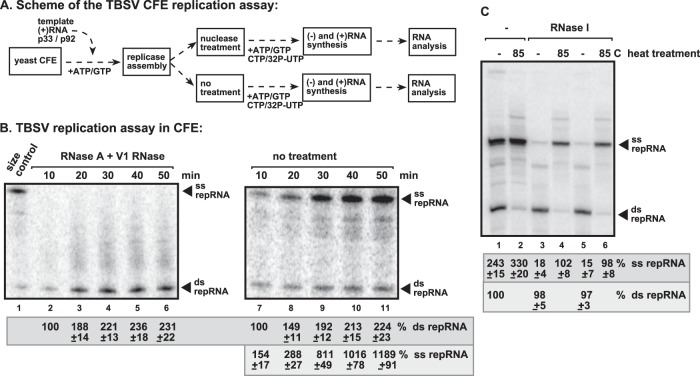FIG 1.
Cell-free TBSV replication assay showing the accumulation of RNase-protected viral dsRNA. (A) Scheme of the CFE-based TBSV replication assay. Purified recombinant p33 and p92pol replication proteins of TBSV, in vitro-transcribed TBSV DI-72 (+)repRNA, GTP, and ATP were added to the whole-cell extract prepared from yeast strain BY4741. After replicase assembly on the membranes present in the CFE, the ssRNA-specific RNase RNase A and the dsRNA-specific V1 nuclease were added to the assay mixture to destroy unprotected RNAs. (B, left) PAGE analysis of the 32P-labeled TBSV dsRNA products produced in the CFE-based TBSV replication assay in the presence of RNase A and RNase V1. (Right) Nondenaturing PAGE detection of ssRNA and dsRNA products produced in the CFE-based TBSV replication assay in the absence of RNases A and V1. The percentages of dsRNA in the samples are shown. (C) Characterization of dsRNA products at the end of the CFE assay. ssRNA-specific RNase I treatment was applied at the end of the replication assay, prior to phenol-chloroform extraction. The odd-numbered lanes represent replicase products that were not heat treated (thus, both ssRNA and dsRNA products are present), while the even-numbered lanes show the heat-treated replicase products (only ssRNA is present). Note that for the nondenatured samples, the dsRNA product represents the annealed (−)RNA and the (+)RNA, while the ssRNA products represent the newly made (+)RNA products. Each experiment was repeated at least three times, and the data were used to calculate standard deviations.

